Quilt Sizes For Beds: Free Printable Guide For Making Quilts
Choosing the right quilt sizes for beds is crucial when it comes to making a quilt pattern for your own home or to give as a gift.
Whether you have a cozy twin bed, a sprawling king, or something in between, you can easily make a quilt that will be the perfect size.
Understand that finding the perfect quilt size isn’t just about matching the dimensions of your mattress and oh by the way there are so many different sizes even for the same mattress size.
You’ll also want to consider the drape, the thickness of your mattress, and whether you want a little extra length for tucking in.
It’s not just about coverage; it’s about creating that inviting, layered look that makes your bed the centerpiece of the room and makes your finished quilt the star
.So let’s get you snug as a bug. We’ll guide you through navigating these sizes, from twin to California King, including extra considerations like the drop on the sides of your bed to achieve that ideal fit.
No more guessing games; just the comfort and style you deserve, tailored to your personal space.
Quilt Size Chart
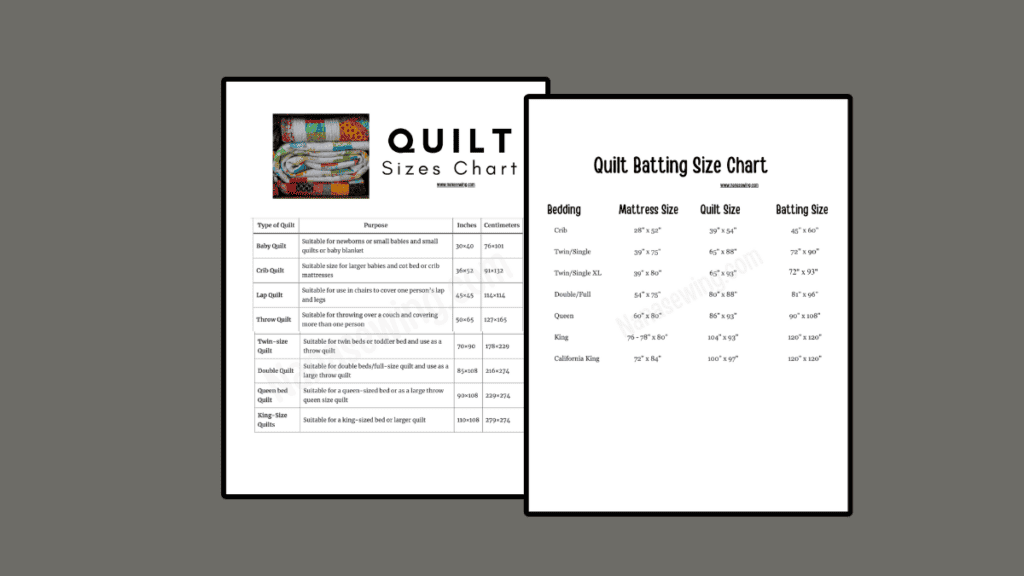
Download: Quilt Size Chart
Our team makes a ton of quilts in a year and we forget what size we need for each one and sometimes patterns are wrong.
We sat down and created a quilt size chart that is a handy resource that covers different sizes of beds. From a standard mattress size, lap quilt, to twin quilts, queen quilt and even a larger quilt.
Keep in mind that beds have a lot of different measurements based upon toppers, material it’s made of etc. Sometimes we take the chart, measure the bed including the length of the sides of the bed to the floor and then design the quilt.
Understanding Quilt Sizes
When you’re picking out a quilt pattern to make, knowing the typical sizes and how they match up with standard bed dimensions is a game-changer for finding that perfect fit.
Crib Quilts usually measure around 45 by 60 inches. They’re designed specifically for little ones, so they fit snugly in a crib without too much overhang.
When you’re hunting for something for a single bed, Twin Quilts are your go-to, measuring approximately 66 by 86 inches. These are wide enough to cover a single sleeper comfortably.
For couples or anyone who enjoys extra space, Queen Quilts hit the mark at about 90 by 90 inches. They’re generously sized for standard queen mattresses, giving you ample coverage.
And let’s not forget about the grand King-Size Quilts. Expect a size of around 108 by 90 inches to lay across your lavish king bed, providing plenty of warmth and decoration.
Here’s a quick table of sizes for reference:
| Quilt Type | Dimensions (inches) |
|---|---|
| Crib | 45 x 60 |
| Twin | 66 x 86 |
| Queen | 90 x 90 |
| King | 108 x 90 |
Photo Credit: Nanasewing.com
Importance of Quilt Sizes for Beds
Choosing the right size of quilt ensures it drapes just how you want it on your bed. If you’re seeking a tidy look, you should match the quilt size closely with your standard mattress sizes. For a more luxurious feel, some folks prefer quilts that extend further down the sides and end of the bed.
In summary, get familiar with these standard quilt sizes because they’ll help you select a quilt that fits not just the bed, but your style and comfort needs too.
Choosing the Right Size
When picking a quilt, it’s essential to consider your mattress size and personal preferences to ensure a perfect fit. Here’s how you get the measurements right and match them with standard quilt sizes.
Measuring Your Mattress
To start, you’ll want to measure your mattress’s width, length, and height. Be sure to include the thickness of your mattress, as higher mattress heights will require larger quilts to cover the sides of the bed adequately.
Use a tape measure to get the length and width from edge to edge, and don’t forget the height measurement from the top of the mattress to where it rests on the bed frame.
- Length measurement: Measure from the head to the foot of the bed.
- Width measurement: Measure from one side of the bed to the other.
- Mattress height: Measure from the top of the mattress to the base.
Quilt Size and Bed Type
Every bed type has a corresponding quilt size guideline. Here’s a quick reference to help you match your bed size with the recommended quilt dimensions:
| Bed Type | Quilt Size (Width x Length) |
|---|---|
| Twin | 68″ x 88″ |
| Twin XL | 68″ x 94″ |
| Full | 84″ x 90″ |
| Queen | 90″ x 95″ |
| King | 108″ x 95″ |
| California King | 102″ x 100″ |
Photo Credit: Nanasewing.com
These measurements include a drop on both sides and the bottom of the bed. However, your personal preference might differ, so consider how much overhang you desire so you can make sure and create a larger quilt.
If you are making this as a gift and they are aware of it, make sure and ask them their preference. Length measurements are crucial to getting the exact size needed for the bed quilts.
Quilt Patterns
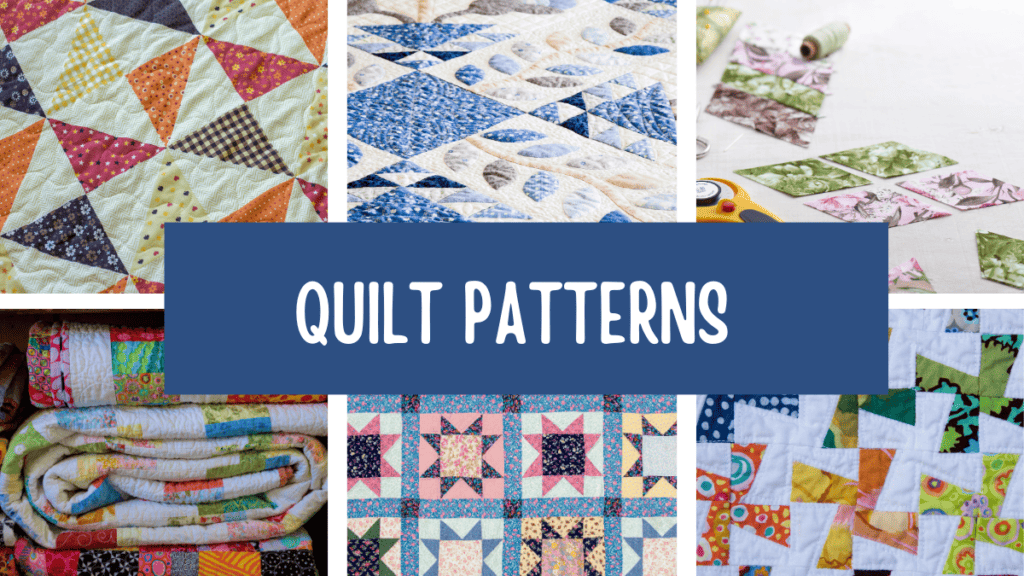
See all Quilt Patterns
When you’re picking out a quilt pattern, it’s worth considering both the functional aspects and the unique styles available. You’ve got options from traditional patterns to modern twists that can change up the look and feel of your bedroom.
If you are a beginner quilter we love these quilt patterns. If you are more experienced, we have 300+ quilt patterns for you to choose from
Specialty Quilts
Specialty quilts go beyond standard sizes and purposes. A baby quilt is usually around 36 inches by 52 inches and is designed specifically for cribs.
Meanwhile, Amish quilts are known for their high-quality stitching and classic patterns, adding a timeless look to any room.
If you’re seeking something specifically crafted for comfort while lounging, lap quilts fit the bill with a typical dimension of 36 inches by 48 inches, just right for draping over your lap.
| Type | Size (inches) | Common Use |
|---|---|---|
| Baby Quilt | 36 x 52 | Cribs |
| Lap Quilt | 36 x 48 | Personal comfort |
| Amish Quilt | Varies | Decorative & functional |
Photo Credit: Nanasewing.com
Creative Quilt Designs
You can add a personal touch to your space with creative quilt designs. Throw quilts are versatile pieces for extra warmth and style, often around 50 inches by 65 inches.
They’re perfect for snuggling on the couch. For something more unique, you could opt for mini quilts, which can serve as wall hangings or table accents.
Want a central focus in your quilt? Go for a central medallion quilt top, which frames a single, prominent design and builds around it.
When you’re making a new quilt, playing with quilt patterns can give a one-of-a-kind look, whether you choose a complex geometric design or go with a minimalistic approach.
- Throw Quilts: Around 50 x 65 inches, suitable for cuddling up in.
- Mini Quilts: Small-scale for decorative purposes.
- Central Medallion Quilt Top: Features a main design, with the rest of the quilt complementing it.
Final Touches and Considerations

Before putting the final stitch in your quilt project, consider the batting and small details that add functionality and style to your finished piece.
Deciding on Quilt Batting
Quilt batting comes in various materials and thicknesses, impacting warmth and drape. Your batting size must correspond closely to the finished size of your quilt, with only a slight overage to account for any quilting shrinkage. Here’s a cheat sheet for batting sizes:
- Crib: 45×60 inches
- Twin: 72×90 inches
- Full: 81×96 inches
- Queen: 90×108 inches
- King: 120×120 inches
To ensure your quilt fits perfectly, you often need to purchase a batting that’s slightly larger than the comforter size you’re targeting. Trim it down after quilting for a snug fit inside the duvet cover if that’s your final look.
Details That Make a Difference
Your quilt’s functionality often hinges on the extra features you add. For instance:
- Pillow Tuck: Adding a 10-12 inch surplus at the top allows your quilt to fold over the pillows, avoiding the need for a separate bed skirt.
- Bed Skirt: If you prefer a cleaner look without a pillow tuck, measure your quilt to fall just above where a bed skirt would start.
In addition:
- Labeling: Stitching a personalized label gives your quilt an identity and is a canvas for you to add care instructions or a heartfelt message.
- Binding: Choose a durable material since binding edges are prone to wear.
Remember, the right quilt size doesn’t just cover the mattress; it accounts for enough coverage to hang over the sides and foot of the bed, ensuring complete warmth and style.
Sewing Supplies:
- Fabric
- Rotary Cutter
- Scissors
- Sewing Clips and Sewing Pins
- Magnetic Seam Guide (helps you sew straight lines)
Fabric Giveaway
Enter our monthly fabric giveaway. Simply complete the tasks daily and you will be entered into the drawing. Winner will be randomly drawn on the first day of the month and notified via email
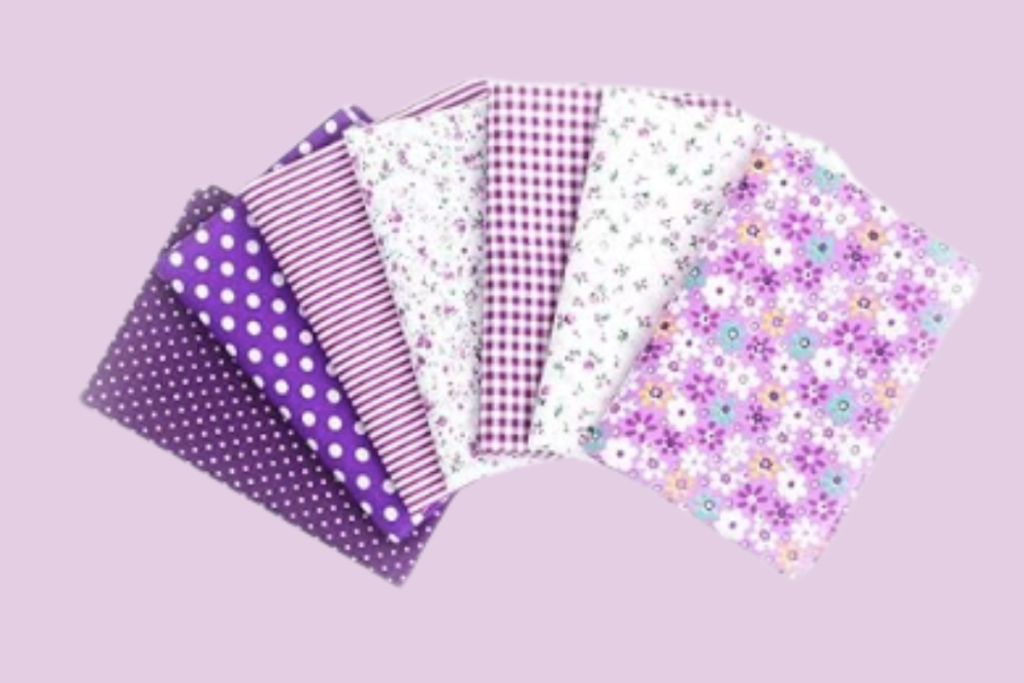

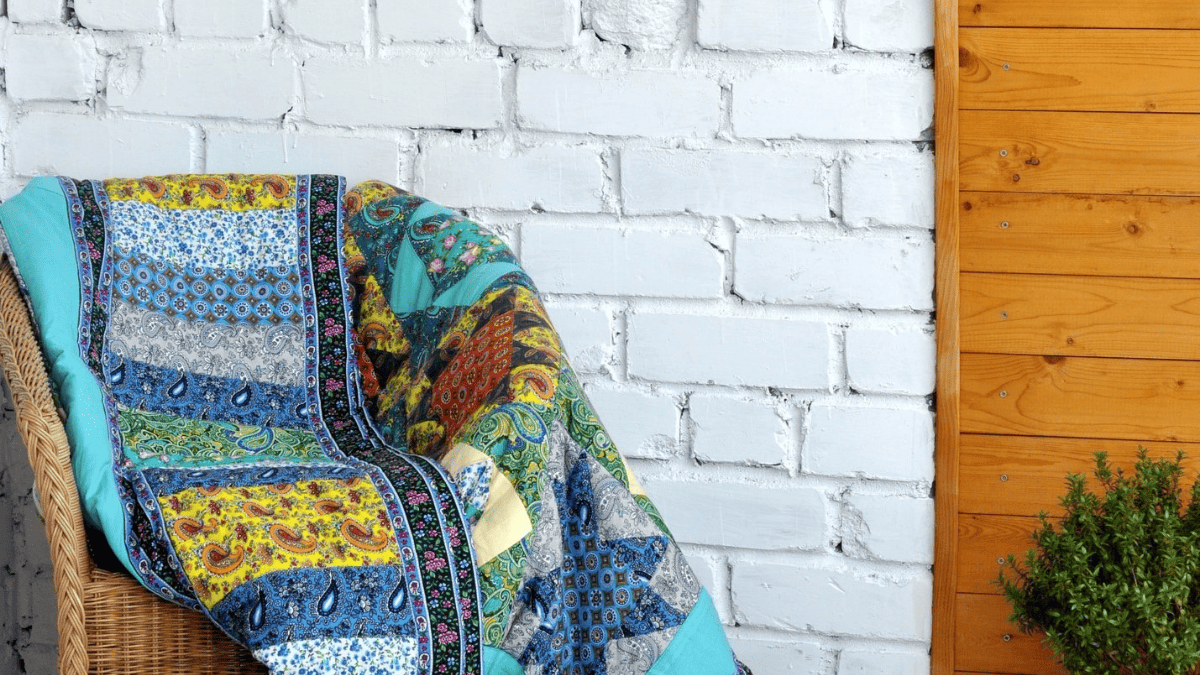
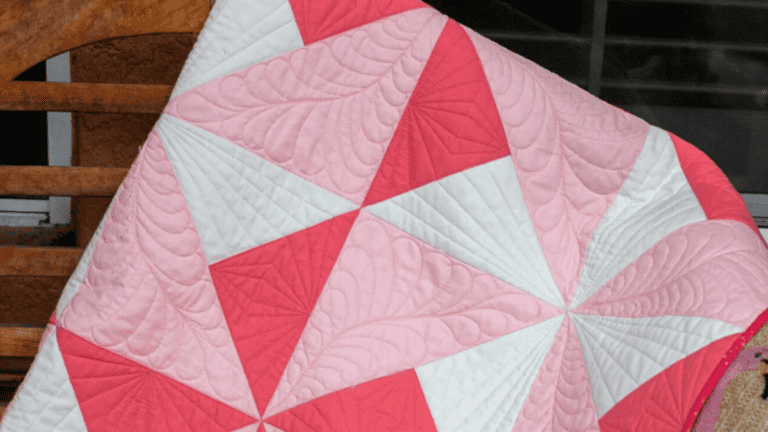

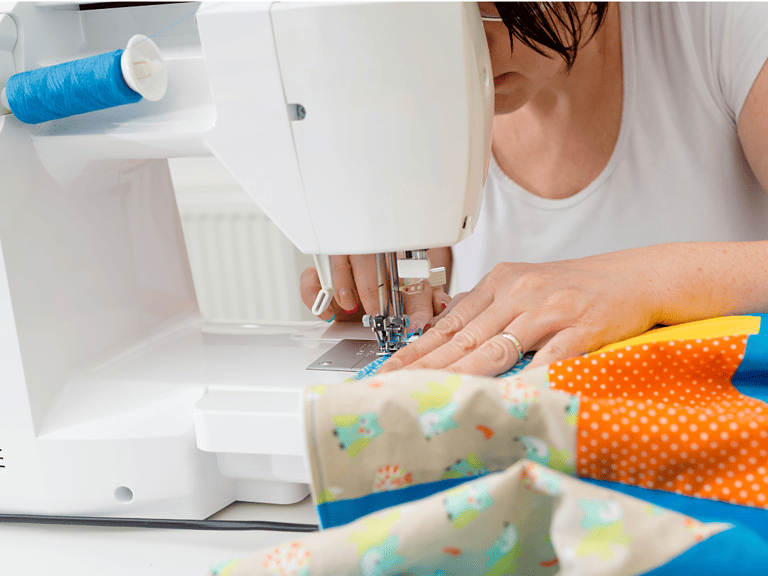
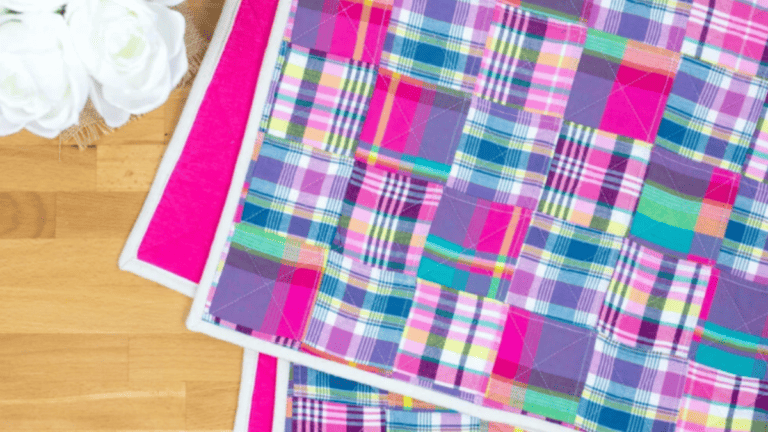
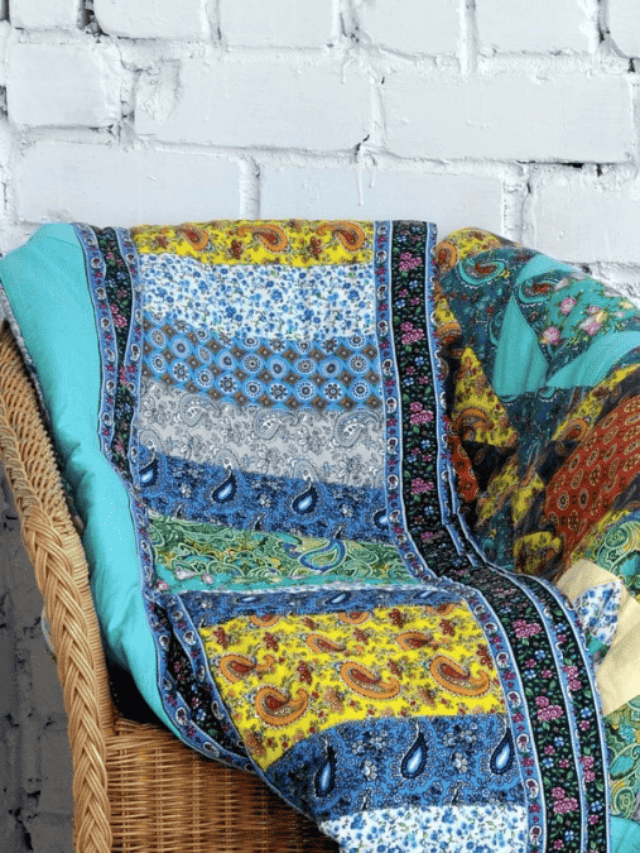
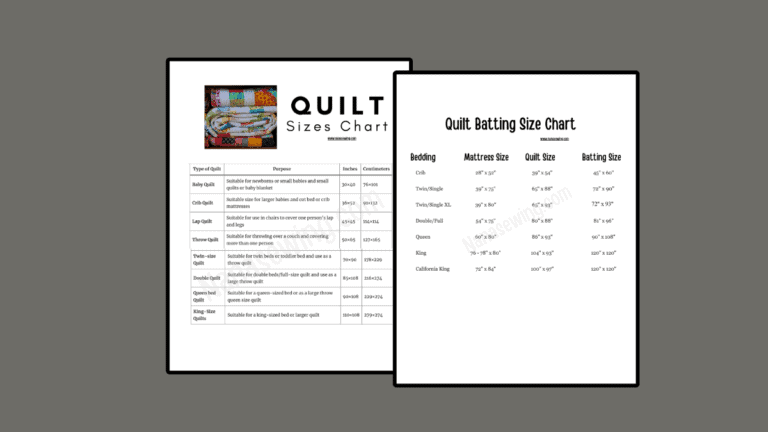
2 Comments